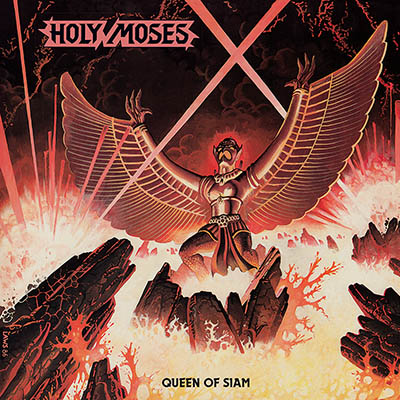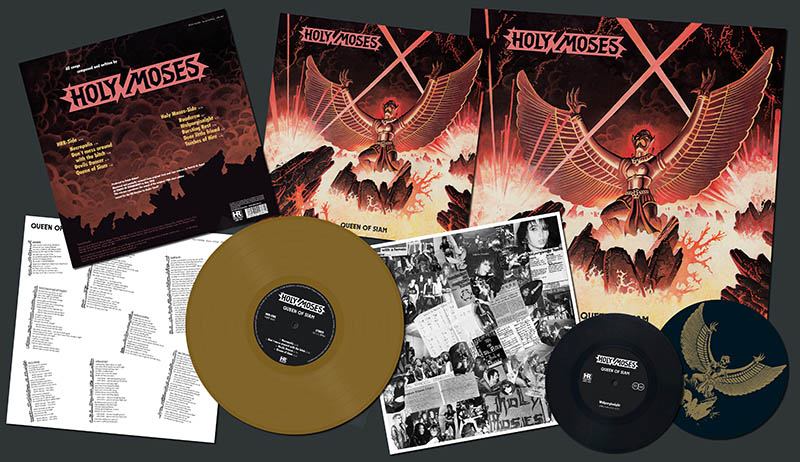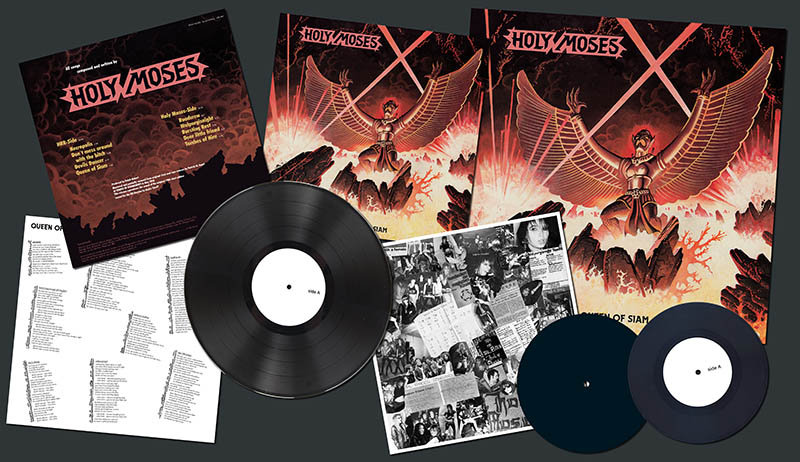 | ||||
| HOLY MOSES - Queen of Siam LP+7 | |
HRR 460, ltd 500, 200 x black + 300 x gold vinyl, 425gsm heavy cardboard cover, lyric innersleeve, poster, one sided black vinyl Bonus 7" with silkscreen print on b side | |
| Sabina Classen - Vocals Andy Classen - Guitars Ramon Brüssler - Bass Herbert Dreger -(R.I.P. 2012) Drums | |
| -Necropolis -Don't Mess Around With The Bitch -Devils Dancer -Queen Of Siam -Roadcrew -Walpurgisnight -Bursting Rest -Dear Little Friend -Torches Of Hire -Walpurgisnight (Alternate Mix) | |
| SOLD OUT! | |
“Queen of Siam” was the very first official full-length album by Holy Moses.
Sabina Classen, famous front woman of the legendary thrash outfit, still remembers exactly what it felt like to finally record and release the debut LP: “Recording an album was a completely new thing for both me and the rest of the band. Prior to ‘Queen of Siam’ we only had recorded one sample song in a studio, “Walpurgisnight” which was then released on the ‘Metallic Bunnys’ Sampler. When we got our record deal a couple of weeks later, we were completely clueless about how things worked at a studio. I had been used to play with the band during rehearsals, where we all would be playing together, and now we had to record every instrument separately, with the vocals coming last. That was a completely new experience for me – there was no chance to watch the others playing, to see what they were doing on the fretboards at a certain moment and to react to it, or to watch the cymbals and snare for my entry. It was very exciting and inspiring, a whole new world to discover – to see how music is mixed, how a mixing desk works, the whole process! Another new thing was to work with a producer, who would give us some helpful advice, like ‘Why don’t you shorten that song a bit?’ etc. It took us no longer than fourteen days to record everything, and then the waiting began… When we finally got to lay our hands on the vinyl, I was overwhelmed. I couldn’t believe that I was holding a record with our very own music in my hands – I was so moved and proud, I almost couldn’t believe it.”
Before recording “Queen of Siam”, Holy Moses had released a good handful of demos, two of which came out before Sabina joined the band. Sabina remembers that she actually had no idea of what they were doing, or what a demo actually was: “Some friends simply came to our rehearsals, set up a cassette recorder and pressed rec. They copied the tape a couple of times and gave it out to friends or sold it for the production price. Only in 1985 we made the first conscious attempt to record a demo, using VHS tapes. That was about the time when Andy got into production. Back then we simply played our songs with the whole band together and took the version with the fewest wrong notes in it. Our producer explained to us that the first versions of most of our songs were too long, so we shortened them down and also changed the song order. Not all of our demo songs made it onto the album.”
“Queen of Siam” originally appeared on the Bochum-based independent label Aaarrg.
There’s a crazy story attached to how Holy Moses scored that deal:
“We had no idea how record companies work. I thought that only bands like Black Sabbath or AC/DC would get record deals, and I would never have dreamt of us signing such a deal – so we didn’t really plan on that or were not aiming for this, we weren’t even thinking about this. But again, it were our friends who thought that we should send those cassettes to some record companies. First we didn’t want to, but then in 1985 we gave it a try. Andy had drawn a cover artwork and we sent the demo to a couple of addresses – really only three or four. One of those tapes ended up at YUP Musik in Bochum. They called us and said that they wanted to meet us, mainly because they couldn’t believe that there was a female vocalist singing. They assumed we had used some kind of device or trick to make the voice sound like that. So they put us to test: When we arrived at Ralph Hubert’s studio, we were asked to play a track live. So we played ‘Walpurgisnight’ – and YUP seriously took that version and put it on the ‘Metallic Bunnys’ sampler. They also gave us a contract that day. We took it home, were about to sign it, and a couple of days later we got another call from Ralph Hubert. He told us that YUP didn’t exist anymore, and that he had founded a new label, AAARRGG Records, and that he’d be working with a huge distributor (SPV). We had no idea what he was talking about, but we went to Bochum and signed the contract. A bit later we returned to Bochum and stayed there for fourteen days to record ‘Queen of Siam’”.
All songs on “Queen of Siam” had been written by Sabina, Ramon and Andy between 1980 and 1984. The line up changes on the drum position had no real effect on the whole process, because when Herbert Dreger joined the band, the drum recordings for “Queen of Siam” had already been completed. Production duties were taken over by Ralph Hubert, “the man behind everything”, as Sabina puts it. At first, the band was shocked by his suggestion to shorten the songs, but in the end they trusted him, especially as this alterations did not change the feeling of the album. Ralph Hubert trained the band to play their parts as perfectly as possible. “He had so much perseverance and was a true perfectionist. I still remember how he made Andy rehearse one of his solos over and over again, because he wasn’t contented with his technique and the way he delivered the notes. Andy spent all night at the studio, practicing that solo only, and the next morning, when he could play it perfectly, Ralph made him rehearse it backwards, because that would sound even better. The next night Andy spent practicing again, this time in reverse, and too perfection, and the next morning Ralph told him it had all been a joke, and that we would take the first version of the solo. But that’s just how he was; he loved to challenge us.”
The end product of the recordings was pure cult, even if the sound can simply not be compared to what could have been achieved in a bigger and better equipped studio, as Sabina frankly admits: “By today’s standards, Ralph’s old studio wouldn’t even pass as a home-recording studio, but for us it was the best we could possibly imagine. As a child I once visited New York where I got to meet the Bee Gees in their studio which already in 1979 was absolutely top notch, but you simply cannot compare this to what we had in Bochum. We were absolutely contented with the outcome, it was already so much better than our demo recordings from the rehearsal room.”
As the album is a true matter of the heart, Sabina finds it hard to pick a favourite song: “Wow, that’s a hard one. You know, when you lay your hands on your very first record, you are so connected to every bit of it, every single song is your favourite song, because you know exactly how much time, effort and love you put into making them. But to name at least one: Walpurgisnight still means so much to me, and if I had to pick one, it would be this song.”
Even if she had the chance, Sabina wouldn’t change a single note on “Queen of Siam”, because “this is the reality of 1986/85. I am so very happy that High Roller Records has given us the opportunity to re-release the album as it is, without any wannabe-remixes that could only do harm to the album. I definitely would not want this.”
2016 marks the 30th anniversary of “Queen of Siam”. This is quite a long time, but Sabina still remembers how press and fans reacted to the Holy Moses debut – the reception was rather mixed, right? “I can remember very well, you know, I have collected all press clippings in a folder, and yes, it couldn’t have been any more mixed, ranging from ‘worst band in the world’ to ‘newcomer of the year’; some journalists hated my vocals or the sound while some fanzines started calling me ‘the queen of death metal’ which made me wonder, because I didn’t know about these terms at all, death metal and thrash metal etc.; we had started playing our music when it was simply called hard rock, or metal, plain and simple. The album definitely allowed us to build a solid fanbase. People either loved us or hated us, and I am still so very proud of that!”
Releasing “Queen of Siam” did of course mean that Holy Moses had to learn how to deal with people’s strong reactions to their music; seeing one’s own creation scrutinized and criticized by the metal press is something one has to get used to. “Sure; especially when people start to envy you. We were not used to being talked about at all, but we learned to deal with it and we didn’t really care. We wanted to have fun doing what we were doing. Also, we started organising gigs further away from Aachen, playing together with other bands. We realized that we really had to work on ourselves and to get as much live experience as possible. Then the first major problem appeared: Herbert, our drummer, got to a point where he no longer wanted to be a part of Holy Moses – he was not really into the heavy music we made with Holy Moses and he rather would go on playing classic hard rock. So when we got the chance to go on tour together with Agent Steel he left, and Ulli Kusch came in as his replacement.
Aachen lies on the far west border of Germany, therefore Holy Moses where somewhat cut off from the famous Ruhr Area, where the heart of Teutonic thrash was beating: “Yes, that’s absolutely true. Aachen was a bit of an island, really isolated; we had no clue about the scene and only got our first contacts there through our record label. We were so floored by what was going on in the scene and it were the people of the “Pott” who finally told us that what we were playing was called thrash metal!! That term hadn’t even made its way to Aachen yet!” Pre-internet days, that’s for sure – all the more amazing when you know that it takes less than two hours to get from Aachen to the Ruhr Area! “Years later Tom Angelripper of Sodom told me that we were actually sneered at by the people of the Ruhr Area scene; both because we were from Aachen and because we had started out as the “school band of the Inda-grammar school”
Tom also told me that we had another conversation that I myself can hardly remember: He said he wanted to test me, to see if I was o.k. or not, and so he asked me what the name of the patron saint of the mineworkers was (Tom was working in the mines back then) and my answer came like a shot: “That’s Saint Barbara, of course!” Then I told him that my father had worked as a pit foreman before he went to university. That was my initiation into the Ruhr Area scene, and Tom and I have been close friends ever since.”
Holy Moses did have a following, but mainly in Belgium and in the Netherlands: “Over there a lot of people thought we were Dutch ourselves. We all spoke Dutch and French, as we grew up so close to the border. So even before we had our first album out we had gained some reputation and acceptance in the Dutch and Belgian underground scenes.”
When Holy Moses started out, it was a rare thing to see a woman fronting a metal band, a lot rarer than today: “Back then, there simply were no female singers. Period. On the other hand, it was of zero importance for us if there were other female metal vocalists or not. It was the metal press that brought the topic up. We really didn’t care. Only in 1986 I heard of Dawn Crosby of Détente who was said to sound quite like me. We eventually got in touch and even had plans for doing a tour together, but sadly she passed away shortly before the tour could be realised.”
That “Queen of Siam” is re-released via High Roller Records is thanks to one of Germany’s most important metal authorities: It was Götz Kühnemund, editor-in-chief of the Deaf Forever magazine, who made the contact: “Yes, he got in touch with both us and HRR in early 2015 and then everything went really fast. Götz told me that the HRR people were really nice and easy to work with, and I for my part trust Götz very much, and I found that he was right. The HRR crew is a bunch of really dedicated fans with a lot of background knowledge, and with so much passion. That had been truly important to me and I am very happy that Holy Moses and HRR are now working together.”
Talking about background knowledge, there is something about the title “Queen of Siam” that has kept me wondering: In 1980, six years before the debut’s release, Lydia Lunch brought out her album called “Queen of Siam” – were Holy Moses aware of this album? And, besides, who is the Queen of Siam they’re singing about?
“Oh, that’s very interesting, I hear this for the first time. I think I’d have to ask Ramon if he knew about that. Our ‘Queen of Siam’ was the girl he was dating at that time. Ramon was studying geography and ethnology and he travelled very often to Thailand where he found her, his very own ‘Queen of Siam’”.
Asked if there is anything else everyone should know about “Queen of Siam”, Sabina is overwhelmed with emotion: “Wow, that is an interesting question, it goes really deep – to be honest, it actually moves me to tears. Perhaps I have only just now realized that this album really was the beginning of everything, it has changed my life forever. ‘Queen of Siam’ opened the door to another world, one I hadn’t even dreamt of. It was the beginning of that wicked and wonderful thing you call life, and I think it was all meant to be like this.”
Ulrike Schmitz


